449. Purple Roller Coracias naevius (Groottroupant)
Order: Coraciiformes. Family: Coraciidae
Description
33-38 cm. The largest roller of the region and the dullest of the rollers. ln spite of its attractive purple, blue and brown colours, this roller usually appears dark in the field.
Adult: Upper parts mainly dark olive green, with conspicuous white supercilium extending into white frons; small pale patch on hind crown. Rump bluish purple. Tail square, purple-blue, with dark greenish centre. Sides of head and chin to breast pale purple-brown, heavily streaked white. Lower flanks, belly and undertail coverts unstreaked and bluer than breast. Marginal upper wing coverts pale pink, lesser and median coverts bright lilac to dark purple, greater coverts vinaceous-brown; primary coverts and alula purple.
Juvenile similar to adult but duller with broader white streaks.
Distribution
Occurs across sub-Saharan Africa; in southern Africa it is widespread but uncommon in northern and central Namibia, Botswana, Zimbabwe, southern Mozambique and north-eastern South Africa.
Habitat
Dry, open woodland and savanna.
Diet
Mainly eats insects, supplemented with other small animals such as scorpions, small reptiles, mice and even young birds, doing most of its hunting by sitting and scanning the vegetation.
Breeding
Monogamous, territorial solitary nester. Courtship is elaborate, with pairs feeding one another and performing spectacular aerial displays. The nest is usually a cavity in a tree, at least 5 m above ground; it may also use a rock crevice or vertical pipe. It lays 2-4 white eggs in the period from May-June, peaking from October-April. The young are fed and incubated by both parents.
Call
In display flight repeatedly utters a harsh karaa-karaa while flying with an exaggerated, side-to-side, rocking motion. Listen to Bird Call.
Status
Fairly common resident, but uncommon in north-eastern South Africa.
Africa Wild Bird Book
- Mel
- Global Moderator
- Posts: 26737
- Joined: Sat May 19, 2012 12:31 pm
- Country: Germany
- Location: Föhr
- Contact:
Purple Roller
God put me on earth to accomplish a certain amount of things. Right now I'm so far behind that I'll never die.
- Mel
- Global Moderator
- Posts: 26737
- Joined: Sat May 19, 2012 12:31 pm
- Country: Germany
- Location: Föhr
- Contact:
Purple Roller Photos
449. Purple Roller Coracias naevius
 © Mel
© Mel
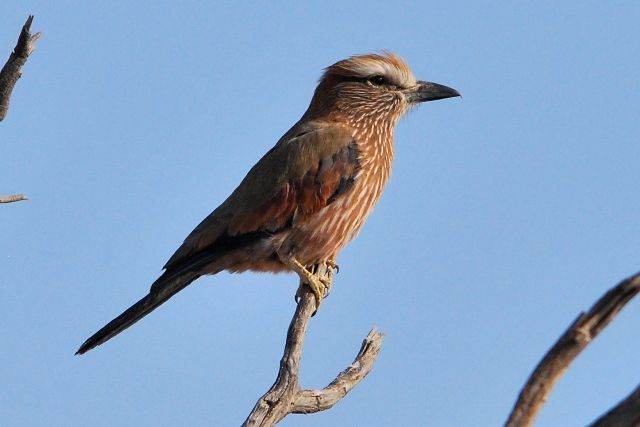 © Mel
© Mel
 © nan
© nan
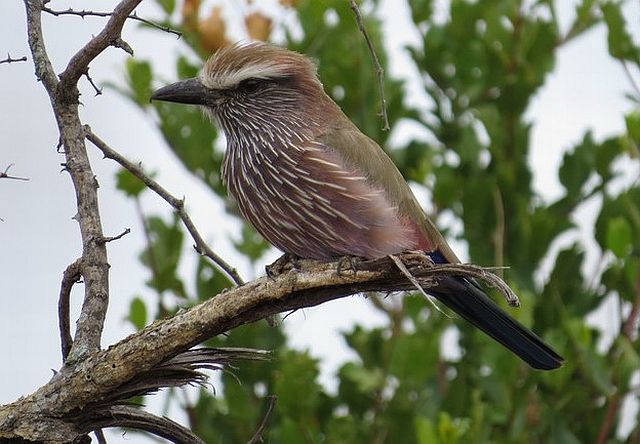 © The Cow
© The Cow
 © Flutterby
© Flutterby
 © Dewi
© Dewi
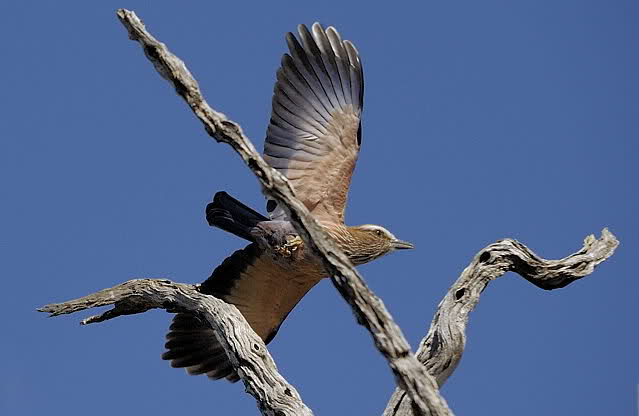 © Dewi
© Dewi
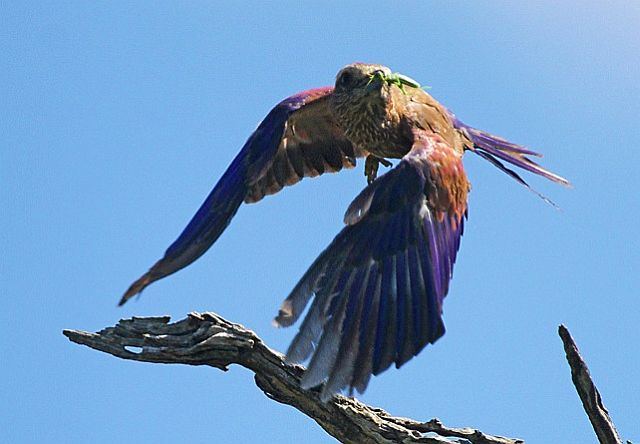 © leachy
© leachy
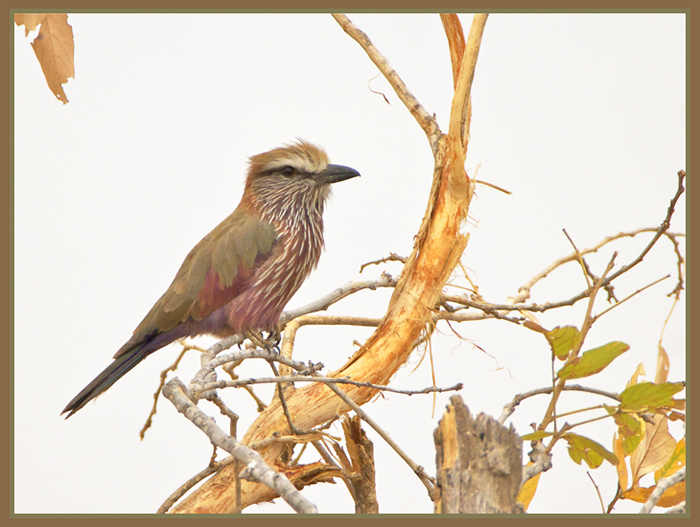 © ExFmem
© ExFmem
Links:
Species text in The Atlas of Southern African Birds
Sabap2
 © Mel
© Mel © Mel
© Mel © nan
© nan © The Cow
© The Cow © Flutterby
© Flutterby © Dewi
© Dewi © Dewi
© Dewi © leachy
© leachy © ExFmem
© ExFmemLinks:
Species text in The Atlas of Southern African Birds
Sabap2
God put me on earth to accomplish a certain amount of things. Right now I'm so far behind that I'll never die.
Lilac-breasted Roller
447. Lilac-breasted Roller Coracias caudatus (Gewone Troupant)
Order: Coraciiformes. Family: Coraciidae
Description
29 cm (36 cm incl. streamers) Only roller with lilac throat and breast and blue belly. The Lilac-breasted Roller is a heavy billed, beautifully coloured bird. Large head with a washed green crown, a short thick neck and a white chin that contrasts with the bright lilac breast and blue underparts; shoulder of the wing, outer webs of flight feathers and rump are violet. Brown back. The tail is narrow and the outer tail feathers are elongated and darker blackish. Long, straight outer tail streamers are absent during moult (post-breading). The black beak is strong, arched and hooked-tipped. The eyes are brown. Legs greenish yellow. Both sexes have the same colouration.
Juvenile is duller with brownish wash on crown and nape; tail streamers absent.
Distribution
The species is found throughout Eastern and Southern Africa, from Ethiopia south through Tanzania, southern DRC, Zambia and Angola to southern Africa. Within southern Africa it is common in Namibia (excluding the Namib Desert), Botswana, Zimbabwe, Mozambique and north-eastern South Africa.
Habitat
It generally prefers dry woodland, such as Acacia savanna, miombo woodland, palm savanna and mopane woodland. It often occupies the border between woodland and grassy clearings, using the former for breeding and the latter for foraging.
Diet
It feeds on a wide variety of animals, especially insects (eg. locusts, crickets, beetles, butterflies), mainly hunting by sitting tight on a perch before pouncing on nearby prey. It preys on lizards and invertebrates but is also known to take small birds. The bird is often seen perched singly or in pairs on telephone wires and at the tops of trees, watching for their food of choice - mainly insects such as grasshoppers and large beetles, scorpions, snails and occasionally lizards.
Breeding
Monogamous solitary nester, vigorously defending its nest against intruders, even outside the breeding season. Nesting takes place in a hole in a tree, either a natural hole or one conveniently excavated by a woodpecker or barbet. They do not excavate their own nests. It may also kick other birds out of their nests, such as Green Wood-hoopoe or Cape Glossy starling. It also uses nest boxes and termite mounds as nests. Egg-laying season is from August-February, peaking from September-December. It lays 2-4 eggs, which are incubated by both sexes for 17-25 days. The chicks stay in the nest for about 19 days, after which they are dependent on their parents for about 20 more days.
Call
Not very vocal. In courtship flight the male's call is a harsh ghak, ghak, gharrak. Listen to Bird Call.
Status
Common resident. Generally sedentary with some local movements recorded; usually found singly or in pairs.
Order: Coraciiformes. Family: Coraciidae
Description
29 cm (36 cm incl. streamers) Only roller with lilac throat and breast and blue belly. The Lilac-breasted Roller is a heavy billed, beautifully coloured bird. Large head with a washed green crown, a short thick neck and a white chin that contrasts with the bright lilac breast and blue underparts; shoulder of the wing, outer webs of flight feathers and rump are violet. Brown back. The tail is narrow and the outer tail feathers are elongated and darker blackish. Long, straight outer tail streamers are absent during moult (post-breading). The black beak is strong, arched and hooked-tipped. The eyes are brown. Legs greenish yellow. Both sexes have the same colouration.
Juvenile is duller with brownish wash on crown and nape; tail streamers absent.
Distribution
The species is found throughout Eastern and Southern Africa, from Ethiopia south through Tanzania, southern DRC, Zambia and Angola to southern Africa. Within southern Africa it is common in Namibia (excluding the Namib Desert), Botswana, Zimbabwe, Mozambique and north-eastern South Africa.
Habitat
It generally prefers dry woodland, such as Acacia savanna, miombo woodland, palm savanna and mopane woodland. It often occupies the border between woodland and grassy clearings, using the former for breeding and the latter for foraging.
Diet
It feeds on a wide variety of animals, especially insects (eg. locusts, crickets, beetles, butterflies), mainly hunting by sitting tight on a perch before pouncing on nearby prey. It preys on lizards and invertebrates but is also known to take small birds. The bird is often seen perched singly or in pairs on telephone wires and at the tops of trees, watching for their food of choice - mainly insects such as grasshoppers and large beetles, scorpions, snails and occasionally lizards.
Breeding
Monogamous solitary nester, vigorously defending its nest against intruders, even outside the breeding season. Nesting takes place in a hole in a tree, either a natural hole or one conveniently excavated by a woodpecker or barbet. They do not excavate their own nests. It may also kick other birds out of their nests, such as Green Wood-hoopoe or Cape Glossy starling. It also uses nest boxes and termite mounds as nests. Egg-laying season is from August-February, peaking from September-December. It lays 2-4 eggs, which are incubated by both sexes for 17-25 days. The chicks stay in the nest for about 19 days, after which they are dependent on their parents for about 20 more days.
Call
Not very vocal. In courtship flight the male's call is a harsh ghak, ghak, gharrak. Listen to Bird Call.
Status
Common resident. Generally sedentary with some local movements recorded; usually found singly or in pairs.
Lilac-breasted Roller Photos
447. Lilac-breasted Roller Coracias caudatus
 © Toko
© Toko
 © Dewi
© Dewi
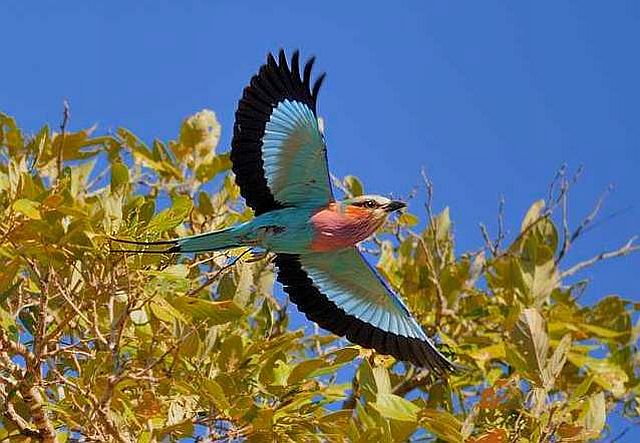 © Dewi
© Dewi
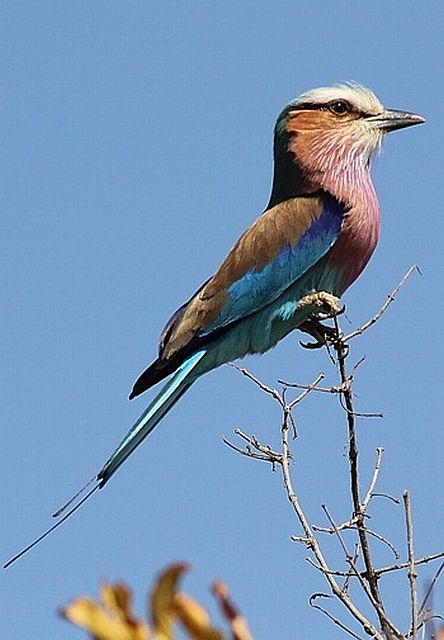 © Amoli
© Amoli
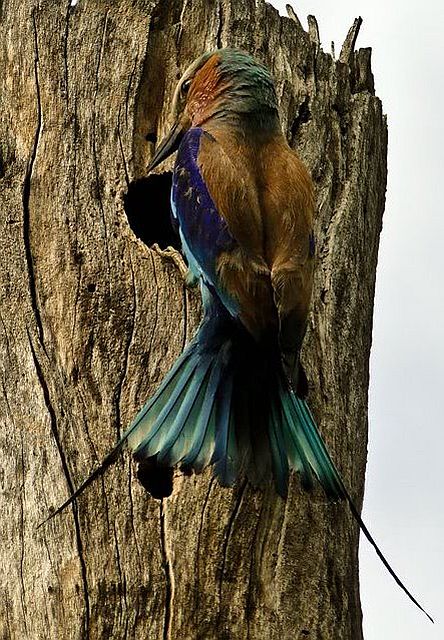 © JustN@ture
© JustN@ture
 © leachy
© leachy
 © leachy
© leachy
 © ExFmem
© ExFmem
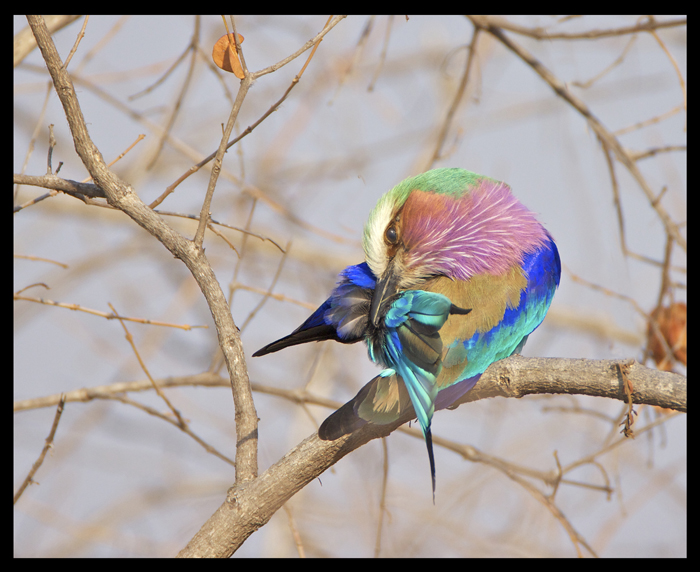 © ExFmem
© ExFmem
Links:
Sabap2
 © Toko
© Toko © Dewi
© Dewi © Dewi
© Dewi © Amoli
© Amoli © JustN@ture
© JustN@ture © leachy
© leachy © leachy
© leachy © ExFmem
© ExFmem © ExFmem
© ExFmemLinks:
Sabap2
- Bushveld Jock
- Posts: 2001
- Joined: Sat Jun 02, 2012 3:52 pm
- Contact:
European Roller
446. European Roller Coracias garrulus (Europese troupant)
Order: Coraciiformes. Family: Coraciidae
Description
Size 30-31 cm. It is mainly blue with an orange-brown back and black flight feathers. The head, neck and underparts are light blue, whilst the upperparts are brownish-orange. A short, thin black stripe runs through the eye and the tail is greenish-blue with a darker base. In flight the brilliant azure blue leading edge and the contrasting black wing-tips can be seen. Sexes are similar, but the juvenile is a drabber version of the adult, more olivaceous green than blue, and throat brownish.
Distribution
Breeds in Morocco, Spain, Poland, Siberia and India. In southern Africa it is a locally common summer visitor to northern and central Namibia, Botswana, Zimbabwe, Mozambique and north-eastern and central South Africa. The European Roller is the only member of the roller family of birds to breed in Europe. It migrates vast distances between continents.

Habitat
It generally prefers savanna, such as broad-leaved and Acacia woodland.
Movements and migration
The European Roller migrates vast distances between continents. From the breeding grounds of Europe and Asia, the roller flies over 10,000 kilometres to sub-Saharan Africa, repeating the mammoth journey again in spring. The movement in early April of hundreds of thousands of rollers travelling north in a narrow corridor along the coast, from Tanzania to Somalia, is one of Africa’s most spectacularly visible migrations.
Diet
Mainly eats flying insects, such as termite alates, beetles and locusts, rarely eating small vertebrates. It typically hunts from a perch, waiting until prey gets close before pouncing on it.
Breeding
Whilst on its breeding ground, the monogamous European roller will defend a territory with its mating partner. Within this territory a nest site is situated in a hole in a large tree, building, cliff or riverbank. A clutch of one to seven, but most commonly four or five, eggs are laid from May to June. The eggs are incubated, primarily by the female, for 17 to 19 days. The chicks hatch naked and blind, but quickly develop, and fledge after 25 to 30 days. The young continue to be fed by adults for a further three weeks or more.
Call
Mostly silent but sometimes utters a harsh rack-kack, kacker. Listen to Bird Call.
Status
Fairly common non-breeding migrant, present from Oct/Nov in north of region, reaching Southern Cape from late Dec. Departs Mar/Apr.
This species has undergone rapid declines across its global range and it is consequently considered Near Threatened. Declines have been most pronounced in northern populations. Threats include persecution on migration in some Mediterranean countries and hundreds, perhaps thousands, are shot for food in Oman every spring. Use of pesticides reduces food availability, and the species is sensitive to changing farming and forestry practices.
Order: Coraciiformes. Family: Coraciidae
Description
Size 30-31 cm. It is mainly blue with an orange-brown back and black flight feathers. The head, neck and underparts are light blue, whilst the upperparts are brownish-orange. A short, thin black stripe runs through the eye and the tail is greenish-blue with a darker base. In flight the brilliant azure blue leading edge and the contrasting black wing-tips can be seen. Sexes are similar, but the juvenile is a drabber version of the adult, more olivaceous green than blue, and throat brownish.
Distribution
Breeds in Morocco, Spain, Poland, Siberia and India. In southern Africa it is a locally common summer visitor to northern and central Namibia, Botswana, Zimbabwe, Mozambique and north-eastern and central South Africa. The European Roller is the only member of the roller family of birds to breed in Europe. It migrates vast distances between continents.

Habitat
It generally prefers savanna, such as broad-leaved and Acacia woodland.
Movements and migration
The European Roller migrates vast distances between continents. From the breeding grounds of Europe and Asia, the roller flies over 10,000 kilometres to sub-Saharan Africa, repeating the mammoth journey again in spring. The movement in early April of hundreds of thousands of rollers travelling north in a narrow corridor along the coast, from Tanzania to Somalia, is one of Africa’s most spectacularly visible migrations.
Diet
Mainly eats flying insects, such as termite alates, beetles and locusts, rarely eating small vertebrates. It typically hunts from a perch, waiting until prey gets close before pouncing on it.
Breeding
Whilst on its breeding ground, the monogamous European roller will defend a territory with its mating partner. Within this territory a nest site is situated in a hole in a large tree, building, cliff or riverbank. A clutch of one to seven, but most commonly four or five, eggs are laid from May to June. The eggs are incubated, primarily by the female, for 17 to 19 days. The chicks hatch naked and blind, but quickly develop, and fledge after 25 to 30 days. The young continue to be fed by adults for a further three weeks or more.
Call
Mostly silent but sometimes utters a harsh rack-kack, kacker. Listen to Bird Call.
Status
Fairly common non-breeding migrant, present from Oct/Nov in north of region, reaching Southern Cape from late Dec. Departs Mar/Apr.
This species has undergone rapid declines across its global range and it is consequently considered Near Threatened. Declines have been most pronounced in northern populations. Threats include persecution on migration in some Mediterranean countries and hundreds, perhaps thousands, are shot for food in Oman every spring. Use of pesticides reduces food availability, and the species is sensitive to changing farming and forestry practices.
Kgalagadi: Dec 2015
KNP Maroela, Shingwedzi & Pretoriuskop: March 2016
KNP Maroela, Shingwedzi & Pretoriuskop: March 2016
- Bushveld Jock
- Posts: 2001
- Joined: Sat Jun 02, 2012 3:52 pm
- Contact:
European Roller Photos
446. European Roller Coracias garrulus


 © Bushcraft
© Bushcraft
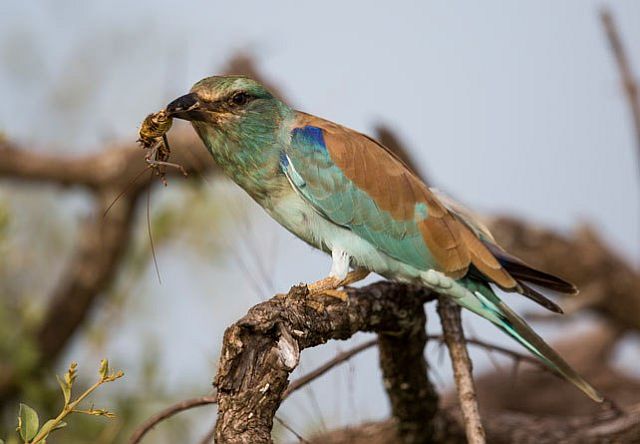 © Pumbaa
© Pumbaa
Kruger National Park
 © leachy
© leachy
 © leachy
© leachy
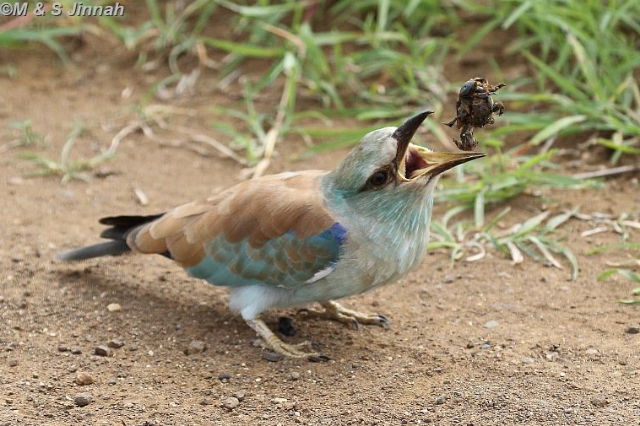 © Duke
© Duke
Kruger National Park
Links:
Species text in The Atlas of Southern African Birds
Sabap2


 © Bushcraft
© Bushcraft © Pumbaa
© PumbaaKruger National Park
 © leachy
© leachy © leachy
© leachy © Duke
© DukeKruger National Park
Links:
Species text in The Atlas of Southern African Birds
Sabap2
Kgalagadi: Dec 2015
KNP Maroela, Shingwedzi & Pretoriuskop: March 2016
KNP Maroela, Shingwedzi & Pretoriuskop: March 2016
- nan
- Posts: 26454
- Joined: Thu May 31, 2012 9:41 pm
- Country: Switzerland
- Location: Central Europe
- Contact:
Broad-billed Roller
450. Broad-billed Roller Eurystomus glaucurus (Geelbektroupant)
Order: Coraciiformes. Family: Coraciidae
Description
29-30 cm. Brown back and head. Lilac foreneck and breast. Pink-brown underparts. Blue in wings. Bright yellow broad bill.
Sexes similar.
Juvenile: drabber; pale breast.
Distribution
Occurs across sub-Saharan Africa; in southern Africa, the subspecies E. g. suahelicus is a wetseason breeding visitor; it is found most commonly in Zimbabwe, the extreme north of Botswana westwards to the Okavango region and in the Caprivi Strip. To the south, the distribution extends into the northern and eastern Transvaal to northeastern KwaZulu-Natal.

Habitat
It generally prefers savanna and clearings in woodlands.
Movements
Intra-African breeding migrant, mainly breeding in southern Africa before moving north in the non-breeding season. Flocks start to arrive in southern Africa in September, leaving in the period from December to April.
Diet
It is a specialist predator, mainly eating swarming termite and ant alates, as well as beetles and bugs. It hunts aerially, often in large flocks.
Breeding
It mainly nests in unlined cavities about 5-15 m above ground, usually in a tree but occasionally in a barn. It lays 2-4 eggs, typically timed with the emergence of insects after rain.
Call
k-k-k-k-k-r-r-r-r-r. Listen to Bird Call.
Status
Locally common summer visitor.
Order: Coraciiformes. Family: Coraciidae
Description
29-30 cm. Brown back and head. Lilac foreneck and breast. Pink-brown underparts. Blue in wings. Bright yellow broad bill.
Sexes similar.
Juvenile: drabber; pale breast.
Distribution
Occurs across sub-Saharan Africa; in southern Africa, the subspecies E. g. suahelicus is a wetseason breeding visitor; it is found most commonly in Zimbabwe, the extreme north of Botswana westwards to the Okavango region and in the Caprivi Strip. To the south, the distribution extends into the northern and eastern Transvaal to northeastern KwaZulu-Natal.

Habitat
It generally prefers savanna and clearings in woodlands.
Movements
Intra-African breeding migrant, mainly breeding in southern Africa before moving north in the non-breeding season. Flocks start to arrive in southern Africa in September, leaving in the period from December to April.
Diet
It is a specialist predator, mainly eating swarming termite and ant alates, as well as beetles and bugs. It hunts aerially, often in large flocks.
Breeding
It mainly nests in unlined cavities about 5-15 m above ground, usually in a tree but occasionally in a barn. It lays 2-4 eggs, typically timed with the emergence of insects after rain.
Call
k-k-k-k-k-r-r-r-r-r. Listen to Bird Call.
Status
Locally common summer visitor.
Kgalagadi lover… for ever
https://safrounet.piwigo.com/
https://safrounet.piwigo.com/
- nan
- Posts: 26454
- Joined: Thu May 31, 2012 9:41 pm
- Country: Switzerland
- Location: Central Europe
- Contact:
Broad-billed Roller Photos
450. Broad-billed Roller Eurystomus glaucurus
 © nan
© nan
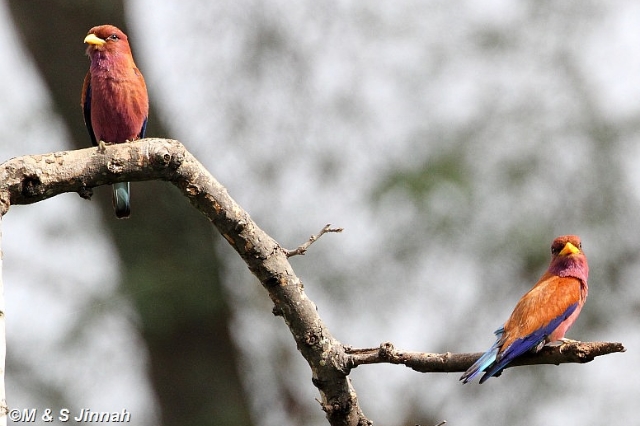 © Duke
© Duke
Kruger National Park, Pafuri area
 © lowveldboy
© lowveldboy
 © lowveldboy
© lowveldboy
 © lowveldboy
© lowveldboy
 © Dindingwe
© Dindingwe
Pafuri
Links:
Species text Sabap1
Sabap2
 © nan
© nan © Duke
© DukeKruger National Park, Pafuri area
 © lowveldboy
© lowveldboy © lowveldboy
© lowveldboy © lowveldboy
© lowveldboyPafuri
Links:
Species text Sabap1
Sabap2
Kgalagadi lover… for ever
https://safrounet.piwigo.com/
https://safrounet.piwigo.com/
Family Alcedinidae (Kingfishers)
Kingfishers are a group of small to medium sized brightly coloured birds in the order Coraciiformes. Kingfishers may look bright blue, but they are actually a murky brown color which is due to the difference between pigmented and structural coloration as the light reflected directly from the wings would be brown, but actually the light bounces around the structure of the wings causing iridescent blue coloring.They have a cosmopolitan distribution, with most species found outside of the Americas. The group is treated either as a single family, Alcedinidae, or as a suborder Alcedines containing three families, Alcedinidae (river kingfishers), Halcyonidae (tree kingfishers), and Cerylidae (water kingfishers). There are roughly 90 species of kingfisher.
The smallest species of kingfisher is the African Dwarf Kingfisher (Ispidina lecontei), which averages at 10.4 g and 10 cm. The largest overall is the Giant Kingfisher (Megaceryle maxima), at an average of 355 g and 45 cm.
The plumage of most kingfishers is bright, with green and blue being the most common colours. The brightness of the colours is neither the product of iridescence or pigments, but is instead caused by the structure of the feathers, which causes scattering of blue light (the Tyndall effect). In most species there are no differences between the sexes.
The kingfishers have a long, dagger-like bill. The bill is usually longer and more compressed in species that hunt fish, and shorter and more broad in species that hunt prey off the ground. They generally have short legs, although species that feed on the ground have longer tarsi. Most species have four toes, three of which are forward pointing.
The irises of most species are dark brown. The kingfishers have excellent vision; they are capable of binocular vision and are thought in particular to have good colour vision. They have restricted movement of their eyes within the eye sockets, instead using head movements in order to track prey. In addition they are able to compensate for the refraction of water and reflection when hunting prey underwater, and are able to judge depth underwater accurately. They also have nictitating membranes that cover the eyes when they hit the water in order to protect them; the Pied Kingfisher has a bony plate which slides across the eye when it hits the water.
The kingfishers have a cosmopolitan distribution, occurring throughout the world's tropics and temperate regions.
Individual species may have massive ranges, like the Common Kingfisher, which ranges from Ireland across Europe, North Africa and Asia as far as the Solomon Islands in Australasia, or the Pied Kingfisher, which has a widespread distribution across Africa and Asia.
Kingfishers feed on a wide variety of items. They are most famous for hunting and eating fish, and some species do specialise in catching fish, but other species take crustaceans, frogs and other amphibians, annelid worms, molluscs, insects, spiders, centipedes, reptiles (including snakes) and even birds and mammals. Individual species may specialise in a few items or take a wide variety of prey, and for species with large global distributions different populations may have different diets. Woodland and forest kingfishers take mainly insects, particularly grasshoppers, whereas the water kingfishers are more specialised in taking fish. Kingfishers usually hunt from an exposed perch, when a prey item is observed the kingfisher swoops down to snatch it, then returns to the perch. Kingfishers of all three families beat larger prey on a perch in order to kill the prey and to dislodge or break protective spines and bones. Having beaten the prey it is manipulated and then swallowed.
Kingfishers are territorial, some species defending their territories vigorously. They are generally monogamous, although cooperative breeding has been observed in some species. In a few species cooperative breeding is quite common.
Like all Coraciiformes, the kingfishers are cavity nesters, with most species nesting in holes dug in the ground. These holes are usually in earth banks on the sides of rivers, lakes or man-made ditches. Some species may nest in holes in trees, the earth clinging to the roots of an uprooted tree, or arboreal nests of termites (termitarium). These termite nests are common in forest species. The nests take the form of a small chamber at the end of a tunnel. Nest-digging duties are shared between the sexes. During the initial excavations the bird may fly at the chosen site with considerable force, and birds have injured themselves fatally while doing this. The length of the tunnels varies by species and location, nests in termitariums are necessarily much shorter than those dug into the earth, and nests in harder substrates are shorter than those in soft soil or sand. The longest tunnels recorded are those of the Giant Kingfisher, which have been found to be 8.5 m long.
The eggs of kingfishers are invariably white and glossy. The typical clutch size varies by species; some of the very large and very small species lay as few as two eggs per clutch, whereas others may lay 10 eggs, the average is around three to six eggs. Both sexes incubate the eggs. The babies of the Kingfisher usually stay with the parents for 3–4 months.
Links:
Africa Wild: Kingfishers - Bird of the Month June 2013
The smallest species of kingfisher is the African Dwarf Kingfisher (Ispidina lecontei), which averages at 10.4 g and 10 cm. The largest overall is the Giant Kingfisher (Megaceryle maxima), at an average of 355 g and 45 cm.
The plumage of most kingfishers is bright, with green and blue being the most common colours. The brightness of the colours is neither the product of iridescence or pigments, but is instead caused by the structure of the feathers, which causes scattering of blue light (the Tyndall effect). In most species there are no differences between the sexes.
The kingfishers have a long, dagger-like bill. The bill is usually longer and more compressed in species that hunt fish, and shorter and more broad in species that hunt prey off the ground. They generally have short legs, although species that feed on the ground have longer tarsi. Most species have four toes, three of which are forward pointing.
The irises of most species are dark brown. The kingfishers have excellent vision; they are capable of binocular vision and are thought in particular to have good colour vision. They have restricted movement of their eyes within the eye sockets, instead using head movements in order to track prey. In addition they are able to compensate for the refraction of water and reflection when hunting prey underwater, and are able to judge depth underwater accurately. They also have nictitating membranes that cover the eyes when they hit the water in order to protect them; the Pied Kingfisher has a bony plate which slides across the eye when it hits the water.
The kingfishers have a cosmopolitan distribution, occurring throughout the world's tropics and temperate regions.
Individual species may have massive ranges, like the Common Kingfisher, which ranges from Ireland across Europe, North Africa and Asia as far as the Solomon Islands in Australasia, or the Pied Kingfisher, which has a widespread distribution across Africa and Asia.
Kingfishers feed on a wide variety of items. They are most famous for hunting and eating fish, and some species do specialise in catching fish, but other species take crustaceans, frogs and other amphibians, annelid worms, molluscs, insects, spiders, centipedes, reptiles (including snakes) and even birds and mammals. Individual species may specialise in a few items or take a wide variety of prey, and for species with large global distributions different populations may have different diets. Woodland and forest kingfishers take mainly insects, particularly grasshoppers, whereas the water kingfishers are more specialised in taking fish. Kingfishers usually hunt from an exposed perch, when a prey item is observed the kingfisher swoops down to snatch it, then returns to the perch. Kingfishers of all three families beat larger prey on a perch in order to kill the prey and to dislodge or break protective spines and bones. Having beaten the prey it is manipulated and then swallowed.
Kingfishers are territorial, some species defending their territories vigorously. They are generally monogamous, although cooperative breeding has been observed in some species. In a few species cooperative breeding is quite common.
Like all Coraciiformes, the kingfishers are cavity nesters, with most species nesting in holes dug in the ground. These holes are usually in earth banks on the sides of rivers, lakes or man-made ditches. Some species may nest in holes in trees, the earth clinging to the roots of an uprooted tree, or arboreal nests of termites (termitarium). These termite nests are common in forest species. The nests take the form of a small chamber at the end of a tunnel. Nest-digging duties are shared between the sexes. During the initial excavations the bird may fly at the chosen site with considerable force, and birds have injured themselves fatally while doing this. The length of the tunnels varies by species and location, nests in termitariums are necessarily much shorter than those dug into the earth, and nests in harder substrates are shorter than those in soft soil or sand. The longest tunnels recorded are those of the Giant Kingfisher, which have been found to be 8.5 m long.
The eggs of kingfishers are invariably white and glossy. The typical clutch size varies by species; some of the very large and very small species lay as few as two eggs per clutch, whereas others may lay 10 eggs, the average is around three to six eggs. Both sexes incubate the eggs. The babies of the Kingfisher usually stay with the parents for 3–4 months.
Links:
Africa Wild: Kingfishers - Bird of the Month June 2013
Family Alcedinidae (Kingfishers) Index
Family Alcedinidae (Kingfishers)
Halcyon leucocephala Grey-headed Kingfisher 436
Halcyon albiventris Brown-hooded Kingfisher 435
Halcyon chelicuti Striped Kingfisher 437
Halcyon malimbica Blue-breasted Kingfisher
Halcyon senegalensis Woodland Kingfisher 433
Halcyon senegaloides Mangrove Kingfisher 434
Ispidina picta African Pygmy Kingfisher 432
Corythornis leucogaster White-bellied Kingfisher
Corythornis cristatus Malachite Kingfisher 431
Alcedo quadribrachys Shining-blue Kingfisher
Alcedo semitorquata Half-collared Kingfisher 430
Megaceryle maxima Giant Kingfisher 429
Ceryle rudis Pied Kingfisher 428
Halcyon leucocephala Grey-headed Kingfisher 436
Halcyon albiventris Brown-hooded Kingfisher 435
Halcyon chelicuti Striped Kingfisher 437
Halcyon malimbica Blue-breasted Kingfisher
Halcyon senegalensis Woodland Kingfisher 433
Halcyon senegaloides Mangrove Kingfisher 434
Ispidina picta African Pygmy Kingfisher 432
Corythornis leucogaster White-bellied Kingfisher
Corythornis cristatus Malachite Kingfisher 431
Alcedo quadribrachys Shining-blue Kingfisher
Alcedo semitorquata Half-collared Kingfisher 430
Megaceryle maxima Giant Kingfisher 429
Ceryle rudis Pied Kingfisher 428


